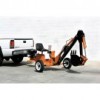Harbor Freight Tools 62365 User Manual - Page 4
Operating Precautions
 |
View all Harbor Freight Tools 62365 manuals
Add to My Manuals
Save this manual to your list of manuals |
Page 4 highlights
Safety Setup Operating Precautions 1. CARBON MONOXIDE HAZARD Using an engine indoors CAN KILL YOU IN MINUTES. Engine exhaust contains carbon monoxide. This is a poison you cannot see or smell. NEVER use inside a home or garage, EVEN IF doors and windows are open. Only use OUTSIDE and far away from windows, doors, and vents. 2. Contact local utility companies before beginning any project. Buried utility lines may not be marked and, if struck, can cause SERIOUS PERSONAL INJURY or DEATH. 3. Keep children away from the equipment, especially while it is operating. 4. Keep all spectators at least 20 feet from the equipment during operation. 5. Fire Hazard! Do not fill fuel tank while engine is running. Do not operate if gasoline has been spilled. Clean spilled gasoline before starting engine. Do not operate near pilot light or open flame. 6. Do not touch engine during use. Let engine cool down after use. 7. Never store fuel or other flammable materials near the engine. 8. Industrial applications must follow OSHA requirements. 9. Do not leave the equipment unattended when it is running. Turn off the equipment (and remove safety keys, if available) before leaving the work area. 10. The equipment can produce high noise levels. Prolonged exposure to noise levels above 85 dBA is hazardous to hearing. Wear ear protection when operating the equipment or when working nearby while it is operating. 11. Wear ANSI-approved safety goggles and hearing protection during use. 12. Do not operate in explosive atmospheres, such as in the presence of flammable liquids, gases, or dust. Gasoline-powered engines may ignite the dust or fumes. 13. People with pacemakers should consult their physician(s) before use. Electromagnetic fields in close proximity to a heart pacemaker could cause pacemaker interference or pacemaker failure. Caution is necessary when near the engine's magneto or recoil starter. 14. Use only accessories that are recommended by Harbor Freight Tools for your model. Accessories that may be suitable for one piece of equipment may become hazardous when used on another piece of equipment. 15. Stay alert, watch what you are doing and use common sense when operating this piece of equipment. Do not use while tired or under the influence of drugs, alcohol or medication. 16. Do not overreach. Keep proper footing and balance at all times. This enables better control of the equipment in unexpected situations. 17. Use this equipment with both hands only. Using equipment with only one hand can easily result in loss of control. 18. Dress properly. Do not wear loose clothing or jewelry. Keep hair, clothing and gloves away from moving parts. Loose clothes, jewelry or long hair can be caught in moving parts. 19. Parts, especially exhaust system components, get very hot during use. Stay clear of hot parts. 20. Do not cover the engine or equipment during operation. 21. Keep the equipment, engine, and surrounding area clean at all times. 22. Use the equipment, accessories, etc., in accordance with these instructions and in the manner intended for the particular type of equipment, taking into account the working conditions and the work to be performed. Use of the equipment for operations different from those intended could result in a hazardous situation. 23. Do not operate the equipment with known leaks in the engine's fuel system. 24. WARNING: Some dust created by power sanding, sawing, grinding, drilling, and other construction activities, contains chemicals known to the State of California to cause cancer and birth defects or other reproductive harm. Some examples of these chemicals are: • Lead from lead-based paints • Crystalline silica from bricks and cement or other masonry products • Arsenic and chromium from chemically treated lumber Your risk from these exposures varies, depending on how often you do this type of work. To reduce your exposure to these chemicals: work in a well ventilated area, and work with approved safety equipment, such as those dust masks that are specially designed to filter out microscopic particles. (California Health & Safety Code § 25249.5, et seq.) Operation Maintenance Page 4 For technical questions, please call 1-888-866-5797. Item 62365













